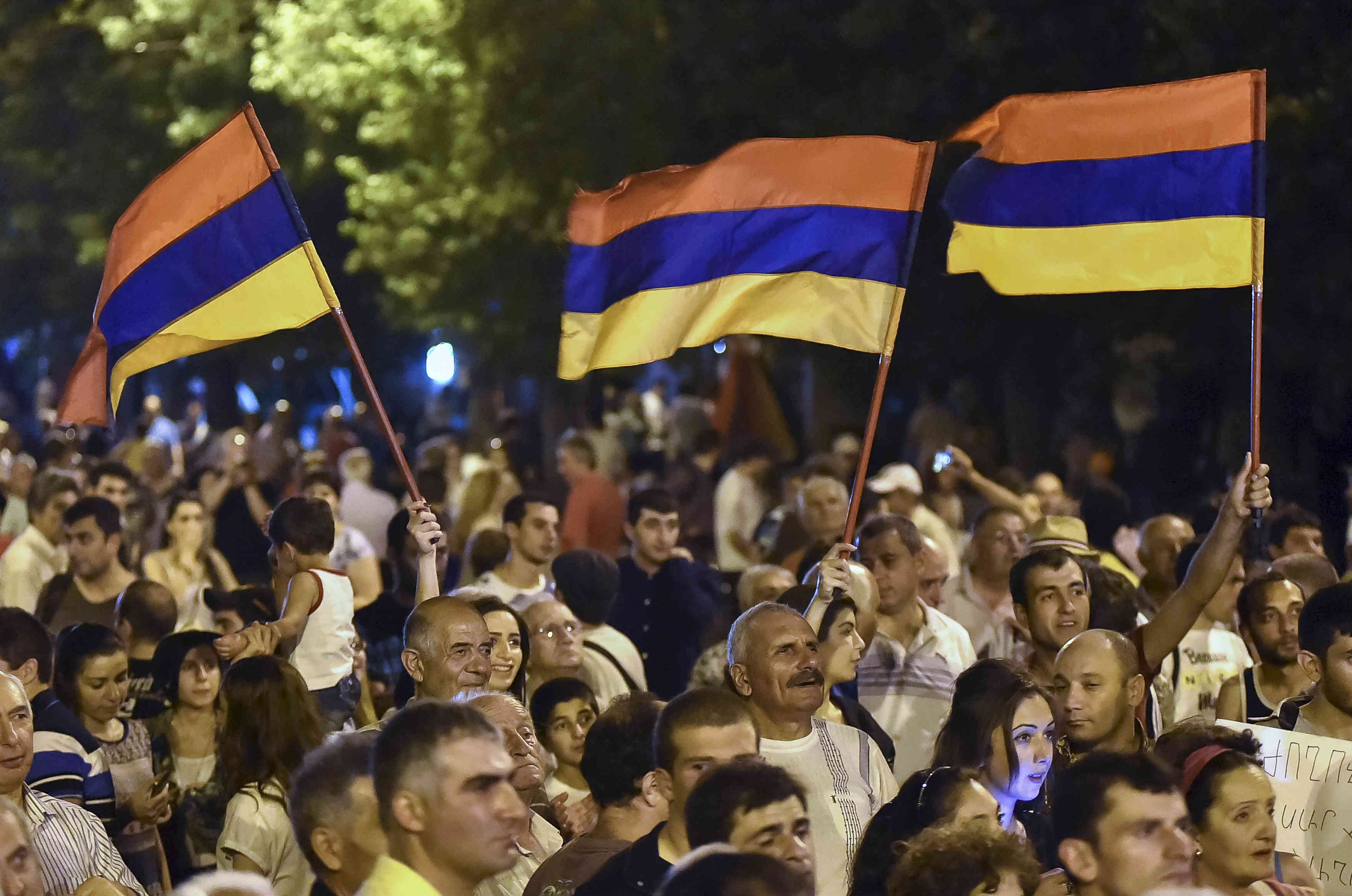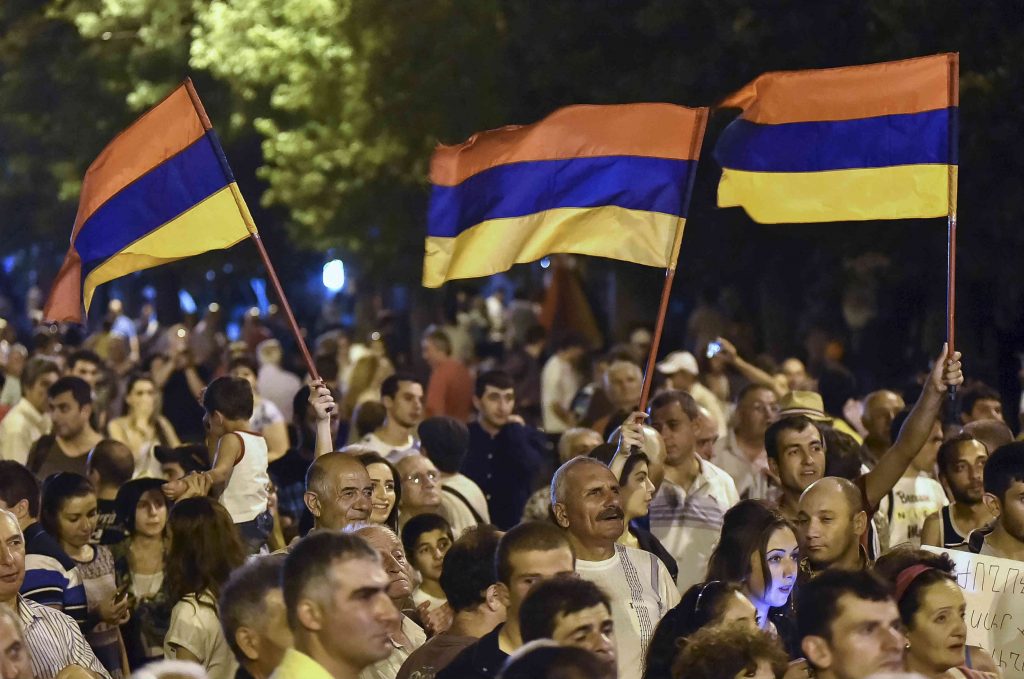 The Electric Yerevan protest officially ended July 7, two weeks after it began as a reaction to the Armenian government’s 16.7 percent increase in electricity prices. But the social movement behind it will likely continue influencing Armenia until the country makes serious political reforms.
The Electric Yerevan protest officially ended July 7, two weeks after it began as a reaction to the Armenian government’s 16.7 percent increase in electricity prices. But the social movement behind it will likely continue influencing Armenia until the country makes serious political reforms.
Thousands marched on Yerevan’s Baghramyan Avenue—a main artery fronting the presidential palace—insisting they weren’t seeking to overthrow the regime but rather to get the government to reverse its price increase. This was not a new Maidan supporting the European Union and opposing corruption. Instead, the 20,000 citizens protesting at its peak took to the streets to express their distrust with traditional political authority.
Electric Yerevan encapsulated what is, even today, a rare phenomenon in the former Soviet Union: a movement for social change. Women helped lead the way and over the past two weeks, demonstrators acquired new skills and loyalties—making them a force the government will be unable to ignore when taking future decisions on prices or significant social issues.
The government hasn’t yet agreed to the protesters’ full demands: revoke the electricity hike and review a 2014 tariff increase. Late last week, Armenian President Serzh Sargsyan offered to subsidize the hike until an audit of Electric Networks of Armenia (ENA) is complete. Protesters refused, saying that if the state budget covers the price hike, costs ultimately still “remain on tax payers who form the state budget.” But since ENA—a unit of Russian energy conglomerate Inter RAO—initially imposed the hike, the President’s fig leaf at least buys time to negotiate a deal with Moscow.
Russia is a leitmotif in the protests. Armenia is one of Russia’s closest allies, and in September 2013, it renounced plans to sign an Association Agreement with the EU, opting instead to join the Russian-led Eurasian Economic Union. Russia runs the 102nd Military Base north of Yerevan and supplies Armenia with deeply discounted weapons. Moscow has promised to ensure security in case of an attack which Armenians worry about because of their unresolved conflict with Azerbaijan over Nagorno-Karabakh. Russian companies control the largest sectors of Armenia’s economy.
Immediately after protests began, Russian media accused the demonstrators of having links with the West. On June 23, President Vladimir Putin’s Press Secretary, Dmitri Peskov, said, “Of course we are watching what’s going on there very closely.” Ukrainian social activists urged Armenians to break free of Moscow’s control.
Nevertheless, the protestors insist they are focussed on improving local governance. After the 2008 parliamentary elections, allegations of electoral fraud triggered demonstrations; at least ten people died in the crackdown that followed. During the 2013 Presidential race, the Organization for Security and Co-operation in Europe noted that “while Election Day was calm and orderly, it was marked by undue interference in the process, mainly by proxies representing the incumbent, and some serious violations were observed.” Sargsyan’s Republican Party of Armenia has a parliamentary majority, followed by the Prosperous Armenia Party, run by a notorious oligarch.
“People don’t believe in politicians or parliament anymore […] they don’t trust the political system,” said Gevorg Ter-Gabrielyan, Director of Eurasia Partnership Foundation Armenia. Consequently what we are seeing today is “a systemic governance crisis,” he said.
Social movements are growing as an alternative to traditional politics. In 2012, groups protested the plans to destroy Yerevan’s Mashtots Park, and in 2013 they opposed public transport fare hikes; both times, the government backed down. During the past decade, women’s groups have also been in the streets to mark 16 Days of Activism, part of a yearly international campaign against domestic violence.
Any price increase is likely to spark outrage in a country that ranks 152nd in global per-capita income, and where 36 percent of its three million inhabitants live below the poverty line. Much of the country survives on remittances sent by the 1.5 million Armenians living and working in Russia.
Today’s protest leaders are young and urban, and have won support from older generations of Armenians who lost out economically in recent years. Many herald from the non-governmental sector and small-medium size private enterprises. While some opposition politicians have joined the protests, they did not play a leading role.
The lack of strategy by some protest organizers and experience sustaining a long-term movement provided an opportunity to the authorities to split the movement into two easier-to-manage factions after the first week of demonstrations when decision making amongst protestors was becoming less transparent, leaving room for dissemination of disinformation and distrust.
Much of the rhetoric, symbols, and tactics used were patriarchal, hierarchical, and nationalistic. Women were especially unhappy. “Early rounds of protests were led in large part by young women 18-20 yrs old, that changed as protests continued on [there were] less women, especially at night,” analyst Karena Avedissian wrote in a Twitter message to me. For Anna Nikogosyan, director of the nonprofit Society Without Violence, “From a feminist point of view it was sometimes so frustrating… the men took ownership of the protests and women were just seen as supporters.”
But during the second week, a core group of activists began employing civic organizing tools to build resistance. They set up working groups on logistics, media relations, IT, and public outreach. They held general assemblies every night, distributed leaflets on community organizing and rights issues, and conducted discussions and debates. Society Without Violence planned to screen a movie about women’s rights activists.
Meanwhile the government was making concessions. On July 3, it tried to partially meet protesters’ third demand: to punish police involved in a June 23 attack that sent at least fifteen demonstrators to local hospitals. The prosecutor launched a criminal investigation against police officers suspected of using excessive force.
On June 6, two weeks after the protests began, police removed the barricades and re-opened Baghramyan Avenue. Now most of the protesters are gone. But in the long term, that might not matter. As rights activist Mamikon Hovsepyan concluded in an interview, “When we are on the streets with all these people we begin to trust each other. Next time, when rights organizations and feminist groups go and demonstrate, we hope that some of our new friends will also come out to support us.”
Sabine Freizer is a Nonresident Senior Fellow at the Atlantic Council’s Dinu Patriciu Eurasia Center and the Program on Transatlantic Relations.
Image: Protesters wave Armenian national flags during a rally against a hike in electricity prices in Yerevan, Armenia July 1, 2015. In a veiled warning to the West, Russia cautioned against any attempt to spark a new "color revolution" in Armenia by exploiting protests against electricity prices for political ends. Large crowds of mostly young people protested in Yerevan for two weeks, demanding the government scrap plans to raise the price of electricity for households. REUTERS/Hayk Baghdasaryan/Photolure

